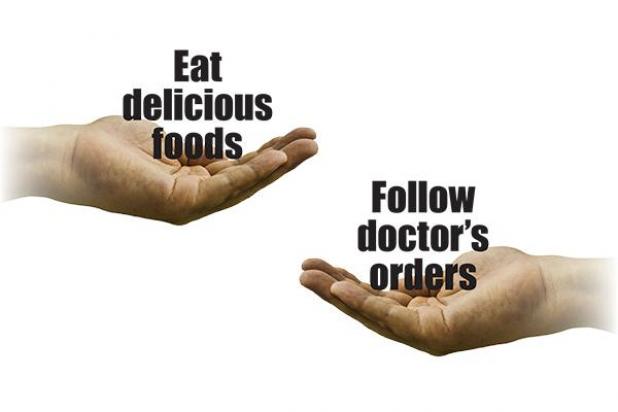
Chef’s tips for eating well mean it doesn’t have to be either/or
A doctor-ordered diet may easily feel like a life sentence of choking down bland, boring food, but it doesn’t have to be. Chef Ace Linne-Speidel shared some practical tips from his kitchen for making the most of meals that follow doctor’s recommendations.
Whether the goal is to limit sodium, lose weight, cut back on sugar or eat less red meat, it can be done without sacrificing taste. “Don’t be scared; just try it,” Linne-Speidel offered as a friendly nudge.
Cook
Sure, eating packaged food or going out to restaurants is easy, but those are also some of the first habits to look at when changing diets. Cooking at home gives an individual control over what goes into a dish. There won’t be any surprises about salt or butter used to prepare a meal, and it can be tailored to meet specific needs.
Cooking at home also means not being limited to a given menu. Have a hankering for dessert? A restaurant likely won’t offer roasted apples or pears on its dessert menu, but they can be a naturally sweet option cooked at home.
Shop strategically
One rule of thumb is to shop the perimeter of the grocery store. Think about it; that’s where produce, meats and dairy are, along with some good frozen options. Start with, and prioritize using, those ingredients.
Shopping in season can help, too. Everybody in this part of the world knows how incomparable corn or peaches are when they’re in season. On the flip side, no one’s looking for watermelon to bring to their holiday parties. Take that practice that seems like common sense and apply it to other produce shopping. Buying tomatoes in January probably won’t give the best flavor, but shopping in season can help make healthy meals taste their best.
If the store you shop at doesn’t carry a needed item, it’s not a bad idea to speak up. The store just might start carrying it, making the quest to follow doctor’s orders that much easier.
Try different cooking methods
It’s hard for someone who dislikes vegetables to fathom shopping the perimeter of the grocery store. Don’t give up, though. Perhaps it’s not the vegetables themselves that’s disliked but rather the way they’ve been cooked.
A can of cooked spinach tastes a lot different than a fresh salad. Likewise, a hunk of raw cauliflower can hardly be compared to the roasted version of the same vegetable seasoned with coriander. Try different vegetables frozen, canned, fresh, steamed, roasted, on their own or mixed into a larger dish. It’s impossible to know what will match one’s preferences without trying different methods.
A look at the spice rack can also be a game changer. Adding salt isn’t the only means for giving food flavor. Try using fresh herbs, garlic and onion, too. Acids like lemon, lime or vinegar can “wake up” a dish that’s lacking something.
Think outside the box
If the mental picture of eating healthy is limited to boiled chicken breast and steamed broccoli, it’s easy to see why a healthy diet might be considered bland and boring. One key to sticking with changes and being satisfied with new meals is variety.
Thinking outside the box, by looking at other cultures for example, can help. Looking for meals that aren’t heavy on meat? Check out some Indian cuisine, which is largely vegetarian. As an added bonus, it also uses spices and herbs that aren’t found in many local recipes, and that can change up a diet that’s getting boring.
Outside-the-box thinking can be applied to typical middle-American foods, too. If chicken and mashed potatoes are on the menu, stock from the chicken can be mixed into the potatoes, giving flavor without loads of butter and salt.
Someone who eats pasta with most meals could try replacing it with rice, quinoa or farro sometimes. A potato can be swapped with a sweet potato, for different flavor and nutrients. Game meats can be a leaner alternative; don’t be afraid to try recipes that call for buffalo or deer.
Make a menu plan
Planning out a week’s worth of menus can help someone trying to implement a new diet succeed. A menu plan will leave less room for impulsively stopping for a meal out or grabbing a TV dinner. Treats and special occasions can be accounted for and balanced out with other healthier meals.
Menu planning can help cut down on spending and food waste, too. With some preparation, a large batch of beans, for example, can be cooked early in the week and used for breakfast burritos, chili and salad throughout the week.
When planning menus, recipes can be found in cookbooks, blogs, Pinterest and Instagram. One of Linne-Speidel’s personal favorites can be found online at www.the naturalnurturer.com. A tip he offers when looking for cookbooks is to avoid fad diets and use those that emphasize healthy, natural eating. “The Flavor Bible” can help those new to cooking learn complimentary combinations for different ingredients.
Start slow
Like taking up running, changing a diet may take some time to build up to the end goal. Easing into a new way of eating may prevent getting discouraged and giving up.
“Moderation is best for everything,” Linne-Speidel said. Change two or three meals a week to start. Eat the ribeye, but opt for a smaller portion. Have dessert every once in a while, but make it a special treat rather than a daily must. Go out to eat at those favorite restaurants, but make educated choices about what to order.
That said, it’s best to check with a doctor to make sure a plan to start slow is OK.
Read the entire Have the Time of Your Life special section online FREE!
